
Wine Culture and Information since 2002 - Volume 22
 Wine Culture and Information since 2002 - Volume 22 |
|
Issue 16, February 2004 |
Contents |
|
|
Young People and Wine |
|
One of the most recurring subjects about the world of wine, and with that the one of distillates and alcoholic beverages, is the relation young people have with these kind of products. An extremely delicate subject, of course, one of those which cannot be taken lightly and with superficiality. Young people are the ones who indisputably represent in every epoch and in every place the future of humanity: the development of customs and of society will inevitably touch their lives. If it is true future is the consequence of present time, and it is right in the future young people will be tomorrow's adults, the responsibility of the ones who in this very moment, the present time, are adults, is to prepare good premises to the ones that, tomorrow, will take their place. Among these responsibilities we believe there is also the must of keeping cultures, traditions, memories of the past and, above all, in the respect of the ones of others. These are presuppositions which allow to understand the present time and to shape the future, in the hope the experience of the past will be useful for not making the same mistakes. Sad to admit, history does not teach anything to men and the inexorable repetition of the same tragedies sadly confirms that. Young people are usually blamed for abusing alcoholic beverages, and this corresponds, in general terms, to the truth. Indeed what preoccupies the most is the abuse, something done by the ones who do not appreciate something or were not educated to the right appreciation and respect of that thing. It should be however noticed the general relationship young people have for wines is, according to many aspects and in general terms, different from the other alcoholic beverages and liquors. Young people seems to pay attention to the quality of wine they drink - this is certainly an extremely positive factor - and, in general terms, it seems they prefer to drink little wine provided it is of good quality. Perhaps this is the consequence of the increasing interest for wine, both from consumers and media, and, it seems, wine is treated with importance and esteem for which, maybe, one is likely to consider it with higher “respect”. Nevertheless wine contributes, uniquely by means of its abuse, to the development of a preoccupying social plague: alcoholism. This is something that, of course, does not play in favor of the beverage of Bacchus and it is something to be not proud of: alcoholism is certainly something to be prevented and contrasted. Nevertheless the ones who can be defined as wine lovers are in no case alcoholists. Whom truly appreciates wine knows very well how to relate to it: whom truly knows and appreciates wine knows moderation is the best way, as well as the most intelligent and wise, to get the maximum pleasure out from this beverage. What is therefore the factor that makes the difference from the ones who appreciate wine to the ones who abuse it? Culture and knowledge. If the abuse of wine among young people is because of the lack of culture and knowledge, therefore they have no faults, indeed the fault is of the society, our society, which was not capable of giving a proper culture to young people, which made them believe the consumption of alcohol, even worse the abuse of alcohol, is something that characterizes “great” people to be taken as an example. What can be done then? Repressing and forbidding the consumption of alcoholic beverages? It would be, we think, even worse. Every adult knows very well that when he or she was young experienced a sort of pleasure in transgressing rules and prohibitions, in a sort of challenge. Moreover, it is historically proven, prohibitionism gave the opposite results in the societies where it was imposed. If culture and education, in the sense of knowing something in the right respect and appreciation, are the factors which allow a better relation to wine, therefore it is right and desirable to work for this goal. There is lots of talk about wine, let us say sometimes are also heard disputable words about wine, and the number of sensorial tasting courses are continuously increasing. This is certainly a positive factor which indicates the spreading of a certain culture and of a conscious interest. An even more positive factor is that to these courses take part lots of young people. A positive sign for which a merit is to be recognized to the many professional and amatorial associations who work since many years in this sense and for the spreading of the right wine culture. Disinformation is always and however a damage for the ones who undergo to it, even worse when it is arbitrarily organized in order to disinform and to reach dishonest and disputable goals. We believe it is hypocritical, as well as not correct and honest, to generalize about the negative effects of wine without saying a single word about its positive effects. Medicine and science continuously inform us about the effects of wine on our health, both positive and negative ones: a good way to inform while simply telling the truth about every single aspect without prejudices. Wine can certainly have negative effects on health, but it is also true this happens only when one abuses of it. Would not it be good, therefore, to rightly educate and inform young people about every aspect, good and bad, about wine? Behaving in a correct way towards someone also means to have his or her respect, and young people must be respected, just like any other group of individuals, without taking advantage from their inexperience and from their desire of learning and growing up. This is also useful for the surviving of wine itself: if young people are taught wine is a negative element, uniquely showing its negative effects and without having it appreciated and known for what it really is, the future of this millenary beverage will be sadly compromised. In this regard we trust the intelligence of young people and their desire of learning and growing up: we wish their intelligence will be useful to them to go beyond the superficiality of things and the simple act of “drinking”. Wine is a culture belonging to tens of people of the world, it is a human heritage and the expression of the human genius which joins nature. Let's try to respect this and respect, first of all, means not abusing of something. Respect is also made of correctness and with absolute correctness must be taught the culture of wine. Anyone appreciating wine knows that what he or she has in the glass is not something to be simply drunk: it is something that must be understood, which can tell thousands things about it by means of senses, with its color, its aromas and taste. It is not something to be drunk in an uncaring and inattentive way. Wine is an extraordinary beverage which deserves respect, and with respect it must be treated, which requires attention, which can give pleasing moments and emotions to the one who has the will to understand it, always remembering that all that is realized with moderation and never with abuse. Well, this is what we should teach young people, to the ones who in a distant future will have the responsibility of passing the culture of wine to the ones who will inevitably be tomorrow's young people.
|
||||
MailBox |
|
In this column are published our reader's mail. If you have any comment or any
question or just want to express your opinion about wine, send your letters to
our editorial or fill in
the form available at
our site.
|
| Why are some wines made with just one grape and others with many grapes? Is there a specific reason for that? |
| Claude Rolland -- Mercurey (France) |
| The reason why a specific number of grapes are used for the production of wine is determined by many factors. The composition of grapes in classical wines is frequently determined by traditional and historical reasons that are usually kept and obeyed. A more specific reason about the quantity, as well as quality, of grapes used for the production of wines is however dependent both by enological and organoleptic needs. Every kind of grape has proper qualities capable of giving wine its character and personality. This property is certainly true for every single variety of grape which can be used for making wine. Qualities of grapes are not just limited to give aromas and taste to wine: this characteristics also depend by fermentation and aging. For example, there are grapes which have a strong acidity and this could be not adequate for the overall balance of wine. In this case it can be added a more “round” and less acid grape in order to give a better balance to wine. The same concept can be applied to aromas: a grape having little and delicate aromas, but good gustatory qualities, can be “improved” by adding a more aromatic grape. However it is good to remember wines produced with just one grape can certainly be excellent, as well as wines produced with more grapes. In both cases the final result strongly depend on the way grapes were cultivated and the way they have been vinified. A grape, alone, certainly is not a guarantee of quality. |
| I heard that also Italian restaurants finally allow their customers to bring a bottle of wine from home while offering a good service on glasses. Can you please tell me about some restaurants in my area? Thank you very much and congratulations for the service you are offering. |
| Franco -- Fogliani (Italy) |
| The service you are talking about is pretty common in many countries, among them United States of America where it is called “bring your own bottle” or BYOB in short. It seems that, finally, even Italian restaurants understood the importance of this service that, if it is true it does not make selling the restaurant's wine, it is also true it does not make it lose a customer. For the uncorking and service of wine is generally requested a pretty variable fee and sometimes it can also be equal to the price of a bottle of an average wine. In every case the restaurant should ensure a good service both on glasses, which need to be washed, and on the service of the wine itself, which needs the assistance of the restaurant's personnel. In Italy is also becoming more and more common the possibility, absolutely and however right, to take home the bottle which was not completely consumed during the meal. Whereas this is a pretty common custom (in some countries it is also possible to take home the foods not consumed and however paid), in Italy there is a sort of prejudice in asking that, both for customers and for restaurant's personnel. Restaurants which are beginning to offer this kind of service usually have special corks to be used in order to allow an easy carrying of the bottle. |
PiedmontThe prestigious Italian wine region is usually associated to great red wines, indeed Piedmont also surprises for the production of white wine and, last but not the least, sparkling wines as well |
|
Piedmont, prestigious Italian wine region, is almost exclusively associated to the production of great red wines, nevertheless it is often forgotten that in this region are also produced excellent white wines and renowned sparkling wines. Indisputably the role of Piedmont in the development of the modern Italian enology is, and was, fundamental: it is right in this region that, as a matter of fact, began that extraordinary revolution which took Italy back to the top of high quality production. Names like Barolo, Barbaresco, Nebbiolo and Barbera are just few examples of wines and grapes which evoke in every wine lover's mind thoughts of quality and enological excellence. Nevertheless the heritage of Piedmont is also rich in white wines and grapes, pleasing and aromatic, not only Muscat Blanc used in the renowned Asti, but also Arneis, Favorita, Cortese and Erbaluce, just to mention the most famous ones of the region. In an enological point of view, Piedmont, when compared to the other Italian regions, represents a sort of exception: here wines are for the most part mono varietal, that is produced with just one grape, and wines produced with more grapes, no matter they are frequent in many areas of the region, represent a minority of the production. Moreover viticulture of Piedmont is usually based on the concept of terroir and cru: a specific wine is exclusively produced with grapes from different vineyards whose name is also used for the definition of the wine itself. Famous is the example offered by two great Piedmont's wines, Barolo and Barbaresco, both making use of this productive concept. Names like Bussia, Lazzarito, Cerequio, Rocche and Brunate are few examples of Barolo's crus, whereas Rabajà, Asili e Montestefano are Barbaresco's. The areas of Barolo and Barbaresco also offer examples for the terroir concept adopted in Piedmont. In these two areas have been individuated some places and communes having peculiar characteristics which give wines their personality. Communes like La Morra, Barolo, Serralunga d'Alba, Monforte d'Alba and Castiglion Falletto are the “privileged” areas for Barolo, whereas Barbaresco, Treiso and Neive are Barbaresco's.
The renaissance of Piedmont's enology, event which had, as a matter of fact, boosted the Italian enology in the world, began around the half of the nineteenth century with the revolution introduced in the production of Barolo. Until that time the production of Piedmont's wines was mainly sweet: a tradition which is probably explained by commercial reasons, when the area of Langhe, where Barolo is from, was the main provider of wines for the powerful Repubblica Marinara of Genoa. From the Ligurian city wines were routed to the sea; therefore a sweet wine could stand better the risks of a long sea journey while ensuring a better keeping. Moreover there is also another explanation on the fact Barolo wine were sweet and the cause was because Nebbiolo, the great grape used for the production of this renowned wine. Nebbiolo has a pretty late maturation and therefore the cold temperature of the Piedmont's cellars during the months on November and December, as well as the lack of specific yeasts, interrupted the process of fermentation therefore leaving a certain quantity of residual sugar. The drastic change of this wine was thanks to a French wine maker: Louis Oudart. Marquise of Barolo, Giulietta Falletti, asked Oudart to improve the wines produced in her cellar. After a preliminary investigation, Louis Oudart understood the huge potentialities of Nebbiolo grape and he also realized the reason why they were not successful in making a good wine: the interruption of fermentation and the excessive quantity of residual sugar. Thanks to his work born Barolo wine and it was a striking success in the whole area: Camillo Benso count of Cavour, who until then did not like Piedmont's wines, was so impressed by the new wine and decided to convert the cellars in his house at Grinzane for the production of the new Barolo. The same did king Vittorio Emanuele II in the vineyards of his hunt lodge of Fontanafredda at Serralunga d'Alba. The history of a great myth was just begun. Wine production of Piedmont is mainly developed in the south-eastern area of the region and in the northern part. The most renowned area of Piedmont is Langhe, an area surrounding the city of Alba, South from Turin, homeland of Barolo and Barbaresco wines. Piedmont is particularly associated to the production of great red wines, indeed in this region are also produced interesting white wines as well as sparkling wines, both sweet and dry. Wines of the region are mainly produced with local grapes, most of the times vinified alone, and the presence of international grapes is pretty modest and are usually used blended with local grapes. Among white berried grapes there are Muscat Blanc, Arneis, Cortese, Favorita and Erbaluce, as well as the less known, and however interesting, Timorasso and Nas-cetta. Among red berried grapes there is the powerful Nebbiolo, as well as Barbera, the most cultivated grape of the region, Dolcetto, Brachetto, Freisa and Grignolino. To these grapes are also included the less known, but however interesting, Vespolina, Bonarda, Uva Rara, Ruchè, Malvasia di Schierano, Malvasia di Casorzo and Pelaverga.
|
||||||||
|
Wines produced in Piedmont are classified according to the quality system in force in Italy, an unified system adopted in every region. The categories of the Italian quality system are, from the lowest to the higher, Vini da tavola (Table Wines), IGT (Indicazione Geografica Tipica), DOC (Denominazione di Origine Controllata) e DOCG (Denominazione di Origine Controllata e Garantita). In the category DOCG is also allowed the indication of the vineyard, of the place or subarea of production - it represents a higher level of quality - a characteristic usually found in Piedmont's DOCG wines, in particular in Barolo and Barbaresco. It should be however noticed the Italian quality system certifies the area of origin of a wine and the respect of the norms set by the disciplinary; real quality, as always, is a presupposition and a principle the producer adopt for his or her wines and on which he or she believes in. DOCG wines produced in Piedmont are (between parentheses the type and the grapes used for the production): Barolo (red; Nebbiolo), Barbaresco (red; Nebbiolo), Gavi (white and sparkling; Cortese), Asti or Moscato d'Asti (white and sparkling; Moscato Bianco), Brachetto d'Acqui (red and sparkling; Brachetto), Gattinara (red; Nebbiolo, Vespolina, Bonarda) and Ghemme (red; Nebbiolo, Vespolina, Uva Rara). The number of areas in Piedmont recognized as DOC are more than 40 and the production is about white and red wines. There also are countless wines produced as IGT, a category of quality, here in Piedmont as it is in other Italian regions, which deserves high attention: no matter it just represents the second level of quality of the Italian system, IGT wines are usually comparable, and sometimes also superior, to the best DOC and DOCG wines.
|
|
Barolo is certainly among the most famous Italian wines and for tens of years it represented Italian enology in the world. This wine is produced with Nebbiolo grape and it is named after the homonymous city located 15 kilometers south from Alba. The production area of Barolo is historically shared by five renowned towns which also represent the best areas: Barolo, Castiglione Falletto, La Morra, Serralunga d'Alba and Monforte d'Alba, from which come the majority of total production. The impact of terroir of these areas on wines is pretty evident and wines produced in the five towns have different and personal characteristics. The composition of the soil in the towns of Barolo and La Morra gives wine a more round character, aromatic and fruity which usually ages faster. The soil of the towns of Castiglione Falletto, Serralunga d'Alba and Monforte d'Alba, less compact and less fertile than the other two towns, produces more robust and intense wines which usually age slower. Wines produced in these towns also differ, in general terms, in color: the ones produces at La Morra and Barolo tend to ruby red colors, whereas the ones produced in the other towns usually have garnet and orange red colors. A typical characteristic of Barolo is the evident astringency because of tannins, a peculiarity which usually needs some years, usually about five, before getting a more round and less aggressive character. This characteristic also gave origin to two “sides” of producers: the ones who believe the production of Barolo should obey to traditional canons, with the result of a more aggressive and typical wine, and the ones who see Barolo as a rounder, modern and immediate wine, usually making use of barrique instead of cask, and diminishing fermentation and maceration times. Both styles have their supporters and this productive characteristic is usually reason of debates both among producers and among wine lovers. No matter these “traditional” or “modern” factors, it is however indisputable the greatness of Barolo. Among the most renowned crus of Barolo should be mentioned: Cannubi, Sarmazza and Brunate at Barolo; Rocche, Cerequio and Brunate at La Morra (Brunate is shared between the towns of Barolo and La Morra); Rocche, Villero and Monprivato at Castiglione Falletto; Lazzarito and Vigna Rionda at Serralunga d'Alba; Bussia, Ginestra and Santo Stefano di Perno at Monforte d'Alba.
|
||||
|
Considered for years as the “lesser brother” of Barolo, because of the Nebbiolo grape used for the production of both, Barbaresco is an extraordinary wine named after the city where it is produced, not far from Barolo. The fame of Barbaresco is more recent than Barolo, however the history of this wine is pretty old. Following the work wine maker Louis Oudart did in Barolo, around the half of 1890's professor Domizio Cavazza, teacher at the Enological School of Alba and director of Cooperative Winery of Barbaresco, he was successful in completely ferment a wine and therefore producing a dry wine. Barbaresco began its path towards notoriety in the 1960's thanks to the commercial efforts of Giovanni Gaja and Bruno Giacosa. It will be ten years later that Barbaresco will become one of the most looked for wines of the world thanks to the intuition and determination of Angelo Gaja, who against everything and everyone, will start making wine according the principles learnt in France. Whether Barbaresco is now admired and renowned everywhere, whether it finally acquired its own dignity and identity, it was thanks to Angelo Gaja who had the courage to start a new process and a new production style, a real and proper revolution, not only a productive one but also a cultural one, which was subsequently joined by many other producers. Barbaresco is produced with Nebbiolo grape and it is usually considered more elegant and refined than the neighboring Barolo. This wine is produced in the towns of Barbaresco, Treiso and Neive, each one of them, thanks to the conditions of the area, gives specific characteristics to wine, in particular the ones produced in certain areas at Neive that sometimes resemble Barolo and for this reason it is said they baroleggiano. Among the most renowned crus of Barbaresco are to be mentioned: Asili, Montefico, Montestefano and Rabajà at Barbaresco; Albesani and Gallina at Neive; Pajorè at Treiso.
|
|
Langhe, an important wine area located near the city of Alba to the left bank of Tanaro river, is not only the homeland of the excellent Barolo and Barbaresco. Nebbiolo certainly is the most important and famous grape, however in this ancient wine land are also cultivated other grapes with which are produced interesting wines. Dolcetto and Barbera certainly represent two grapes of primary importance in this area. Among the most important places for the production of Dolcetto are to be mentioned Dogliani and Diano d'Alba, the latter even recognizes the existence of 77 different crus in its territory. Dolcetto makes wines with an evident fruity character, very pleasing and agreeable, with good tannins but low acidity, a characteristics that does not allow long aging times. Barbera is a grape which only recently obtained good recognition thanks to a careful and qualitative vinification: until some tens years ago it was considered as the most suited grape for the production of coarse and bulk wine. Now Barbera, capable of producing wines with a pleasing crispness, is rightly considered among the great grapes of Piedmont. A very interesting grape of Langhe, which is unfortunately not very known, is Pelaverga, cultivated in the commune of Verduno, capable of producing wines of high interest. Among white berried grapes cultivated in Langhe are to be mentioned Favorita and Arneis, the latter also present in Roero. On the right bank of Tanaro river there is another wine area, Roero, which is recently getting, rightly, higher and higher interest. Also here the most common red berried grape is Nebbiolo, however the initial notoriety of the area was because of a white berried grape: Arneis. This grape was used in the area blended with Nebbiolo in order to produce wines with a less aggressive character. White wines produced with Arneis offer pleasing and truly convincing aromas and tastes. Among red wines of Roero there are Barbera and Nebbiolo, both having different characteristics from the ones of Langhe, anyway having interesting and good value. Results obtained in Roero owe their success to a young vintner who was capable of expressing the quality of this area to the highest levels while being successful in giving a proper identity to Roero: Matteo Correggia. Thanks to his strenuous work for the revaluation of his land's heritage, Matteo Correggia, unfortunately recently passed away because of an accident, was capable of setting an indelible mark in the viticulture of Roero, something which is witnessed by his wines.
|
|
In these two important wine areas of Piedmont, located in the south-eastern part of the region, the dominant red grape is not Nebbiolo but Barbera. Whereas in Monferrato it is frequent a slightly sparkling Barbera, in the area of Asti the same grape is used to make dry and structured wines. Another grape of primary interest in Monferrato is Grignolino used to make wines having a pretty pale color, very pleasing and agreeable. Another typical grape of Monferrato is Freisa, found in many wines of this area. In Monferrato is also present a red berried grape which is not very famous but certainly deserves a better attention, Ruchè, an exclusive heritage of Castagnole Monferrato. In these areas is also found the renowned Brachetto d'Acqui, produced both as sparkling and slightly sparkling, a wine which enchants for its strong aromas and for its agreeability. Another wine which characterizes the area is Gavi, a DOCG white wine, produced with Cortese, one of the noble and valued white berried grapes of Piedmont. Not far from Gavi there is a small town capable of producing an interesting wine: Ovada. In this town the main grape is Dolcetto with which is produced a wine, unfortunately in small quantities, having unique and interesting characteristics. In the area of Asti the most renowned grape is Muscat Blanc used for the production of the renowned sparkling wine named after the homonymous city. The success of Asti Spumante, simply called Asti, has a history of more than one hundred years when Carlo Gancia decided in 1865 to make a sparkling wine using Muscat Blanc. Since then this joyous and aromatic spumante spread everywhere in the world and it is one of the symbols that identifies Italian enology. Asti is produced with the fermentation in pressurized tanks, a system that was invented by an important man of the Italian enology and unfortunately almost forgotten: Federico Martinotti. Among the wines of this area produced with Muscat Blanc is to be mentioned the interesting Loazzolo. Red wine in Asti means Barbera and whether Barbera is now considered among the most important grapes and wines of Piedmont, this was thanks to Giacomo Bologna. Convinced of the potentialities of Barbera, he adopt production systems that were unthinkable at those times in his land, he treasured the experience of his journeys in France, California and Georgia and he finally adopt barrique for the aging of his Barbera: from that moment on the “popular” and “humble” grape acquired a relevant place among important wines.
|
|
The northern area of Piedmont is usually less known than the south-eastern part. No matter Nebbiolo grape is widely used in these areas for the production of good wines, the notoriety of wines from Langhe, Barolo and Barbaresco in particular, does not allow them to have a better spreading. Nevertheless in the past the wines of these areas were considered even better than others, and despite of the scarce notoriety, they still have their charm and value. Among the most renowned areas there are Ghemme and Gattinara, where are produced the homonymous DOCG wines, in which Nebbiolo grape is blended with other typical grapes, and Carema, in the western part and near Vallée d'Aoste, produced with plain Nebbiolo. Among the wines of the area produced with Nebbiolo, alone or blended with other grapes, are to be mentioned Lessona, Bramaterra, Boca, Sizzano and Fara. An interesting white berried grape of this area is Erbaluce with which are produced white wines. This grape is also capable of producing extraordinary sweet wines, very looked for and appreciated, typical of the city of Caluso.
|
ChardonnayAmong the most representative international grapes, Chardonnay is present in every wine country and has a countless number of supporters. But also lots of detractors |
|
Chardonnay. This is probably the most common and recognizable term in the wine parlance. For many Chardonnay is even believed to be the name of a wine and they do not even suspect it is instead the name of a grape. It certainly is a very spread and known grape that from its probable homeland, Bourgogne, it spread everywhere in the world and now it is the most used grape for the production of wines, both alone and blended with other grapes. The spreading of Chardonnay is so wide that since tens of years is considered as an international grape, that is present in many wine countries, probably the international grape par excellence. Whether it does exist a model of “international white wine”, this is almost exclusively because of Chardonnay grape and, in particular, the way it is used. Why is Chardonnay so spread and appreciated in the world? Whether it is true Chardonnay has a countless number of supporters, it is also true that many consider it as an overrated grape. The spreading of Chardonnay is mainly because of its excellent capability of adaptation in the many climate conditions and in the many types of soil. Moreover, Chardonnay is appreciated by many wine makers for its pretty “neutral” characteristics and therefore allows the creation of wines according to precise styles. This versatility has given origin to the so called “international style”, very appreciated by many wine lovers and by many wine makers, also thanks to the use of barriques and of specific wine making techniques: Chardonnay can be virtually “shaped” to the will of the producer. This is certainly not a criticism to Chardonnay, it is just a consideration based on the wide selection of wines produced with this grape, however it should be noticed and remembered there are many wines produced with Chardonnay of primary and absolute greatness. Of course, not all Chardonnays are of good quality: its wide usage has given origin to the production of pretty ordinary wines which are sold as exceptional wines just because they are made with this grape. Despite the opinions of its supporters and of its detractors, an indisputable characteristic of this grape is its adaptability, both in the cultivation and in the production of wine. Chardonnay does not have particular organoleptic characteristics that allow a clear recognizability, and it is just this characteristic that make it suitable for the many wine making techniques. Moreover Chardonnay is also one of the main grapes used for the production of sparkling wines - a typical example is Champagne - and it is widely used, alone or blended with other grapes, for the production of dry white wines, pretty infrequently for the production of sweet wines. Dry white wines produced with Chardonnay can be divided into two distinct categories: the ones fermented and/or aged in cask and the ones fermented and aged in containers made of materials different from wood, such as steel. This productive choice greatly influences the organoleptic qualities of the finished product, a factor which affects, of course, any wine. For Chardonnay, because of its versatility and relative neutrality, the choice of the type of containers to be used for the fermentation and the aging represents a fundamental factor.
We already mentioned the fact that Chardonnay is a grape easily cultivable and ensures a good adaptation in every type of soil and climate, however it is a grape which ripes early and has a moderate acidity. This means it must be harvested earlier than the other grapes and, in case the full maturation is allowed, even worse overripeness, its acidity greatly diminishes producing wines with little crispness and too much roundness, in other words, non balanced wines. For this reason Chardonnay is harvested in advance in order to keep its precious acidity, a factor that becomes of absolute importance when the grape is being used for the production of sparkling wines. Despite Chardonnay offers good capacity of adaptation in the many environmental conditions, it however gives the best and more elegant results in areas having a cool climate, such as Bourgogne. Longevity of Chardonnay is also widely influenced by the way it was vinified. The duration can range from two years, just like the majority of white wines, to an average time of six years, and in particular cases, to be usually considered as exceptions, it can also be more than ten years. The elements that mainly determine the longevity of Chardonnay are the aging in cask, more frequently the barrique, and the grape acidity at the time of harvesting. In case aging or fermentation was done in wood containers, the longevity of Chardonnay can also be of six years or more, whereas it loses its best characteristics after about two years in case it was vinified in steel tanks. Among other conditions determining its longevity is to be added the level of ripeness at the time of harvesting, therefore its acidity. It should be noticed in the process of vinification of Chardonnay is usually favored malolactic fermentation, a practice which is usually done in case the wine is being aged in barrique, giving the wine a character of higher aromatic complexity as well as making it rounder and “complex” to the taste. The definition of the organoleptic characteristics of Chardonnay is pretty complex because of the different wine making styles used. This grape, as we already mentioned, can make very ordinary and coarse wines, in case it was cultivated with pretty high yields and vinified with pretty bad wine making techniques, but also wines of absolute value and quality in case it was cultivated with pretty low yields and careful wine making processes. It should be however noticed the use of wood containers widely alters the character of wine and therefore will be noticed aromas and tastes having no direct connection with the ones of the grape. However, thanks to its versatility, Chardonnay has acquired an its own character and personality which are so evident that it is not usually hard to recognize its presence in wines. Moreover, because of its wide spreading in the world, it is pretty hard to define a real and proper identity for Chardonnay as the environmental and climate conditions of the many places, as well as the many wine making styles, contribute to the overall character of the wine and to its organoleptic qualities.
|
||||||||
|
The appearance of wines produced with Chardonnay grape can have pretty different colors. As we already said, this grape is used with many wine making techniques, therefore the process of fermentation done in cask, as well as the aging, will give wine deeper colors which can range from straw yellow to golden yellow. Things change, in general terms, in case the wine was produced in non wooden containers, usually steel or concrete tanks: the color will be paler with evident nuances of greenish yellow. Even the age of wine will affect color: a characteristic that will particularly be noticed in Chardonnays aged in casks, that is the ones more suited to the aging in bottle. After some years the color of Chardonnay changes just like the typical color seen in other white wines, that is a color tending to golden yellow will be accentuated, a characteristic that will also be confirmed by nuances.
|
|
The evaluation of Chardonnay's aromas is strongly influenced by the vinification style and, last but not the least, by the area of origin and climate. Aromas should be divided in at least two fundamental categories: Chardonnays fermented and/or aged in wood and Chardonnays vinified in non wooden containers. This grape has pretty modest aromatic characteristics, therefore it is strongly affected by productive and cultivation factors. Moreover as some wines produced with Chardonnay can be suited for the aging in bottle, it will be opportune to consider the development of aromas over time. Even the development of aromas will be influenced by the wine making techniques used for the production. It should be however remembered most of Chardonnays, even the ones aged in wood, offer their best qualities when consumed in their youth: Chardonnays really suited for the aging of many years are rather few. Young wines produced with Chardonnay and not aged in wooden containers, therefore consumed in their youth, have aromas of white pulped fruits, such as apple and pear, sometimes citrus fruits as well. Chardonnays produced in cool areas or early harvested, can have aromas of apple, pear, lemon, peach and even melon and mineral aromas. The aromas change when the grape was harvested in warmer areas or when it reaches full maturation: ripe apple, peach, pineapple, passion fruit and tropical fruit. In wines aged in cask the aromatic character passed from wood becomes pretty evident, also according to the duration of toasting of wood and the way it is used, therefore will be perceived aromas of vanilla and toasted wood. Some wines produced with Chardonnay also undergoes the malolactic fermentation process, a production phase which is also used for wines not aged in wood. In this case will be perceived less fresh aromas as well as aromas of ripe fruit: often are also perceived clear aromas of banana and butter. The development of aromas in Chardonnays aged in non wooden containers will be characterized by aromas of cooked fruit and frequently honey as well, last but not the least, aromas of vegetal origin. For Chardonnays aged in wood, the aging in bottle can give origin to more complex and interesting aromas, such as honey, butter, caramel, coffee, toasted wood and hazelnut.
|
||||
|
Chardonnay is a grape having a pretty modest acid component, however when it is harvested early or cultivated in areas having a cool climate, this organoleptic quality can be pretty evident and positively contributes to balance. The general custom is to make Chardonnays with a pretty high alcoholic percentages, even more than 13%, an essential factor in order to have a proper balance in case acidity is pretty evident. The gustatory difference is strongly influenced by the way Chardonnay was vinified: wines produced with aging or fermentation in steel tanks have a higher acidity and a taste that resembles fresh fruit, whereas the ones produced in wooden containers have a rounder, richer and more complex character with a more robust structure.
|
|
Chardonnay certainly is among the most known and common grapes in the world and the organoleptic qualities of its wines are strongly influenced by the production area, but also and mainly by the wine making style. The reference area which strongly influenced the style of the wines produced with this grape is its homeland, Bourgogne, in which are found excellent examples of Chardonnays both produced by making use of wooden containers and of other types. Among the examples of Burgundian Chardonnays produced in steel tanks are to be mentioned the ones from Chablis and Mâconnais, whereas for Chardonnays aged in wood can be mentioned the ones produced in the Côte de Beaune, in particular at Meursault, Chassagne-Montrachet and Puligny-Montrachet. Wines produced in these places have strongly influenced the producers of Chardonnay in the world, however in every area can be noticed a certain typicality. In qualitative productions, Chardonnay is made by making use of cask, probably because producers want to satisfy what the majority of consumers would expect to find in the taste of an “international” wine, however it should be remembered it certainly is not the use of cask that makes quality in a wine. For example Chardonnays produced in Chablis, where the majority of producers do not make use of barrique, can be considered as absolute examples of elegance and class. In Italy Chardonnay is widely spread and here producers vinify it both alone and blended with other grapes, in both cases can be aged in cask or in steel tanks. The production of Chardonnay in the wine countries of the so called “New World” is mainly made by fermenting and/or aging the wine in barrique. Typical examples can be offered by Chardonnays produced in Australia, New Zealand, South Africa, as well as in Chile, Argentina and United States of America, where wines produced with this grape usually have a high alcoholic percentage and a pretty evident “wooden” character.
|
Wines of the Month |
|
|
|
Score legend Prices are to be considered as indicative. Prices may vary according to the country or the shop where wines are bought |
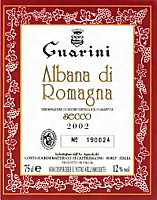
|
|
Albana di Romagna Secco 2002 |
|
| Guido Guarini Matteucci (Italy) | |
| Grapes: Albana | |
| Price: € 3,80 | Score: |
| This wine shows an intense straw yellow color and nuances of straw yellow, very transparent. The nose reveals good personality with intense, clean and pleasing aromas which start with hints of jasmine, honey and apple followed by aromas of chamomile, lily, hawthorn and pear. In the mouth has good correspondence to the nose, a crisp attack and however balanced, good body, intense flavors, agreeable. The finish is persistent with flavors of apple, honey and pear. | |
| Food Match: Mushrooms and vegetables soups, Pasta and risotto with vegetables and fish, Boiled fish | |

|
|
Sangiovese di Romagna Superiore Riserva Mero 2000 |
|
| Guido Guarini Matteucci (Italy) | |
| Grapes: Sangiovese | |
| Price: € 6,20 | Score: |
| This wine shows a brilliant ruby red color and nuances of ruby red, moderate transparency. The nose reveals good personality with clean, intense and pleasing aromas which start with hints of black cherry and plum followed by pleasing aromas of blueberry, toasted wood, tobacco, licorice, vanilla and pleasing hints of cocoa and menthol. In the mouth has good correspondence to the nose, a slightly tannic attack and however balanced by alcohol, good body, intense flavors, good tannins. The finish is persistent with flavors of black cherry, plum and blueberry. Mero ages for 8 months in steel tanks and for 12 months in cask followed by 6 months of aging in bottle. | |
| Food Match: Roasted meat, Broiled meat and barbecue, Hard cheese | |
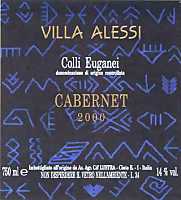
|
|
Colli Euganei Cabernet Villa Alessi Vigna Girapoggio 2000 |
|
| Ca' Lustra (Italy) | |
| Grapes: Cabernet Franc (60%), Cabernet Sauvignon (40%) | |
| Price: € 10,80 | Score: |
| This wine shows a brilliant ruby red color and nuances of ruby red, little transparency. The nose reveals intense, clean, pleasing and elegant aromas which start with hints of black cherry and plum followed by good aromas of blueberry, black currant, violet, vanilla and pleasing hints of licorice and chocolate. In the mouth has good correspondence to the nose, a slightly tannic attack and however well balanced by alcohol, good body, intense flavors. The finish is persistent with pleasing flavors of black cherry, plum and blueberry. This wine ages in cask for at least 24 months. | |
| Food Match: Roasted meat, Braised and stewed meat, Hard cheese | |
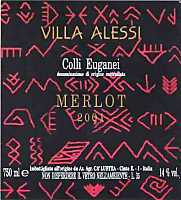
|
|
Colli Euganei Merlot Villa Alessi Vigna Sasso Nero 2001 |
|
| Ca' Lustra (Italy) | |
| Grapes: Merlot | |
| Price: € 9,40 | Score: |
| The wine shows an intense ruby red color and nuances of purple red, little transparency. The nose reveals intense, clean, pleasing and elegant aromas that start with hints of black currant and black cherry followed by good aromas of green bell pepper, plum, licorice, vanilla and pleasing hints of chocolate and tobacco. In the mouth has good correspondence to the nose, a slightly tannic attack and however well balanced by alcohol, good body, intense flavors, agreeable. The finish is persistent with good flavors of black currant, plum and black cherry. This Merlot ages in cask for at least 24 months. | |
| Food Match: Braised and stewed meat with mushrooms, Roasted meat, Hard cheese | |

|
|
Roero Printi 2001 |
|
| Monchiero Carbone (Italy) | |
| Grapes: Nebbiolo | |
| Price: € 25,00 | Score: |
| The wine shows a beautiful and intense ruby red color and nuances of ruby red, little transparency. The nose reveals good personality with intense, clean, pleasing, refined and elegant aromas that start with hints of black cherry and violet followed by good and intense aromas of blueberry, plum, licorice, menthol, thyme and pleasing aromas of toasted wood and vanilla. In the mouth has good correspondence to the nose, a slightly tannic attack and however well balanced by alcohol, full body, intense flavors, good tannins. The finish is persistent with good and intense flavors of black cherry and plum. A well made wine. This Roero ages in cask for at least 24 months followed by one year of aging in bottle. | |
| Food Match: Braised and stewed meat, Game, Roasted meat, Hard cheese | |
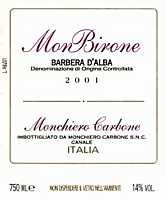
|
|
Barbera d'Alba MonBirone 2001 |
|
| Monchiero Carbone (Italy) | |
| Grapes: Barbera | |
| Price: € 20,00 | Score: |
| The wine shows an intense ruby red color and nuances of ruby red, little transparency. The nose reveals good personality with intense, clean, pleasing, elegant and refined aromas which start with good hints of black cherry and plum followed by good and intense aromas of raspberry, carob, toasted wood, blueberry, blackberry, licorice, vanilla and pleasing hints of cocoa, menthol and black pepper. In the mouth has good correspondence to the nose, a slightly tannic attack and a pleasing crispness, however well balanced by alcohol, full body, intense flavors. The finish is persistent with good flavors of black cherry, blueberry and plum. MonBirone ages in barrique for 12-18 months followed by an aging in bottle of at least 9 months. | |
| Food Match: Braised and stewed meat, Game, Roasted meat, Hard cheese | |

|
|
Barolo Ca'Mia 1999 |
|
| Brovia (Italy) | |
| Grapes: Nebbiolo | |
| Price: € 30,50 | Score: |
| The wine shows a brilliant ruby red color and nuances of garnet red, moderate transparency. The nose reveals intense, clean, pleasing and elegant aromas which start with hints of black cherry jam and dried violet followed by pleasing aromas of raspberry jam, blueberry, plum, licorice, tobacco and pleasing hints of vanilla and leather. In the mouth has good correspondence to the nose, a slightly tannic and pleasingly crisp attack however well balanced by alcohol, good body, intense flavors, good tannins. The finish is persistent with good flavors of black cherry, raspberry and blueberry. This Barolo ages in cask for about 2 years. | |
| Food Match: Braised and stewed meat with mushrooms, Game, Roasted meat, Hard cheese | |
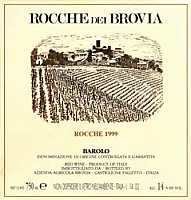
|
|
Barolo Rocche 1999 |
|
| Brovia (Italy) | |
| Grapes: Nebbiolo | |
| Price: € 30,50 | Score: |
| This Barolo shows a brilliant ruby red color and nuances of garnet red, moderate transparency. The nose reveals good personality with intense, clean, pleasing and elegant aromas which start with hints of violet, cherry and raspberry followed by good aromas of strawberry jam, plum jam, licorice, menthol and pleasing hints of vanilla and leather. In the mouth has good correspondence to the nose, a slightly tannic and pleasingly crisp attack however well balanced by alcohol, good body, intense flavors, good tannins. The finish is persistent with good flavors of cherry and raspberry. This Barolo ages in cask for about 2 years. | |
| Food Match: Braised and stewed meat, Roasted meat, Game, Hard cheese | |

|
|
Soave Classico Superiore Vigneti di Foscarino 2001 |
|
| Inama (Italy) | |
| Grapes: Garganega | |
| Price: € 12,00 | Score: |
| The wine shows a brilliant straw yellow color and nuances of greenish yellow, very transparent. The nose reveals good personality with intense, clean, pleasing and elegant aromas that start with hints of pear, broom and toasted wood followed by good aromas of hawthorn, banana, almond, grapefruit, apple, plum, vanilla and pleasing hints of avocado. In the mouth has good correspondence to the nose, a crisp attack however well balanced by alcohol, good body, intense flavors, agreeable. The finish is persistent with flavors of pear, plum and almond. A well made wine. This Soave ferments and ages in barrique for 8 months. | |
| Food Match: Roasted fish, Pasta and risotto with fish and vegetables, Cold cuts | |
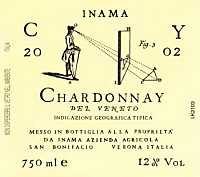
|
|
Chardonnay del Veneto 2002 |
|
| Inama (Italy) | |
| Grapes: Chardonnay | |
| Price: € 7,00 | Score: |
| The wine shows an intense greenish yellow color and nuances of greenish yellow, very transparent. The nose reveals clean, delicate and pleasing aromas which start with hints of banana and acacia followed by aromas of pineapple, broom, litchi, apple and pear. In the mouth has good correspondence to the nose, a crisp attack and however balanced, intense flavors, agreeable. The finish is persistent with flavors of banana and pear. This Chardonnay ferments and ages in steel tanks. | |
| Food Match: Aperitifs, Mushrooms and vegetables soups, Pasta and risotto with vegetables | |
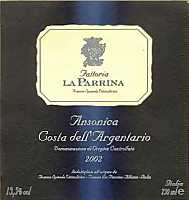
|
|
Ansonica Costa dell'Argentario 2002 |
|
| Tenuta La Parrina (Italy) | |
| Grapes: Ansonica | |
| Price: € 5,20 | Score: |
| The wine shows a brilliant greenish yellow and nuances of greenish yellow, very transparent. The nose reveals clean and pleasing aromas which start with hints of green apple and broom followed by aromas of hawthorn, chamomile, lemon and pear. In the mouth has good correspondence to the nose, a crisp attack and however balanced, intense flavors, agreeable and with good crispness. The finish is persistent with flavors of apple and pear. | |
| Food Match: Vegetables soups, Pasta and risotto with vegetables and crustaceans, Eggs | |
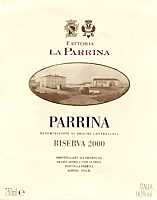
|
|
Parrina Rosso Riserva 2000 |
|
| Tenuta La Parrina (Italy) | |
| Grapes: Sangiovese (70%), Cabernet Sauvignon (10%), Merlot (10%) | |
| Price: € 12,90 | Score: |
| The wine shows an intense ruby red color and nuances of ruby red, little transparency. The nose denotes intense, clean, pleasing and elegant aromas which start with hints of black cherry and blueberry followed by good aromas of raspberry, licorice, plum, violet, vanilla and pleasing hints of chocolate. In the mouth has good correspondence to the nose, a slightly tannic attack and however balanced by alcohol, good body, intense flavors, good tannins, agreeable. The finish is persistent with flavors of black cherry and blueberry. This wine ages for at least one year in barrique followed by an aging in bottle. | |
| Food Match: Stewed and braised meat with mushrooms, Roasted meat, Hard cheese | |
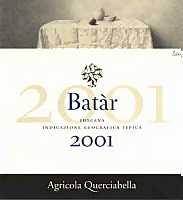
|
|
Batàr 2001 |
|
| Querciabella (Italy) | |
| Grapes: Chardonnay (65%), Pinot Blanc (35%) | |
| Price: € 35,00 | Score: |
| The wine shows a pale golden yellow color and nuances of straw yellow, very transparent. The nose reveals good personality with intense, clean, pleasing, refined and elegant aromas which start with hints of banana, toasted wood and litchi followed by good and intense aromas of coffee, acacia, pineapple, hawthorn, apple, honey, peach, grapefruit and vanilla. In the mouth has very good correspondence to the nose, a crisp and pleasingly round attack, well balanced by alcohol, good body, intense flavors, very agreeable. The finish is persistent with good and intense flavors of banana, grapefruit and apple. A well made wine. Batàr ages for 10 months in barrique and for at least 10 months in bottle. | |
| Food Match: Roasted fish, Stuffed pasta with mushrooms, Roasted white meat, Spiced fish | |
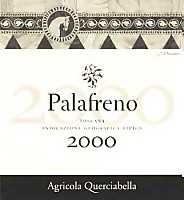
|
|
Palafreno 2000 |
|
| Querciabella (Italy) | |
| Grapes: Merlot (55%), Sangiovese (45%) | |
| Price: € 29,00 | Score: |
| This wine shows an intense ruby red color and nuances of ruby red, little transparency. The nose reveals good personality with intense, clean, pleasing, refined and elegant aromas which start with hints of black cherry, blueberry and plum followed by good aromas of blackberry, tobacco, violet, toasted wood, caramel, licorice, vanilla and hints of cocoa. In the mouth has very good correspondence to the nose, a slightly tannic attack and however balanced by alcohol, full body, good tannins, intense flavors. The finish is persistent with good flavors of black cherry, plum and blueberry. A well made wine. Palafreno ages in barrique for 18 months followed by some months of aging in bottle. | |
| Food Match: Braised and stewed meat, Roasted meat, Game, Hard cheese | |
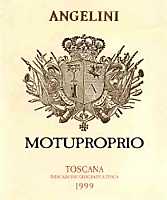
|
|
Motuproprio 1999 |
|
| Tenimenti Angelini (Italy) | |
| Grapes: Cabernet Sauvignon | |
| Price: € 28,00 | Score: |
| This wine shows an intense ruby red color and nuances of ruby red, little transparency. The nose denotes good personality with intense, clean, pleasing and elegant aromas that start with hints of black cherry and plum followed by aromas of blueberry, black currant, toasted wood and hints of carob and cyclamen. In the mouth has good correspondence to the nose, a slightly tannic attack and however balanced, full body, intense flavors, good tannins, agreeable. The finish is persistent with flavors of black cherry, blueberry and plum. Motuproprio ages for 18 months in barrique and for 9 months in bottle. | |
| Food Match: Braised and stewed meat, Roasted meat, Game, Hard cheese | |
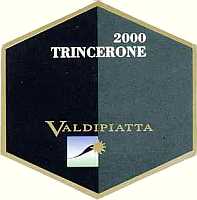
|
|
Trincerone 2000 |
|
| Tenuta Valdipiatta (Italy) | |
| Grapes: Canaiolo Nero (60%), Merlot (40%) | |
| Price: € 15,00 | Score: |
| The wine shows a deep ruby red color and nuances of ruby red, little transparency. The nose reveals intense, clean, pleasing, elegant and refined aromas that start with hints of black cherry and violet followed by good aromas of blueberry, blackberry, plum, black currant, licorice, carob, tobacco and pleasing hints of vanilla and menthol. In the mouth has good correspondence to the nose, a slightly tannic attack and however well balanced by alcohol, full body, intense flavors, good tannins. The finish is persistent with flavors of plum, black cherry and blueberry. A well made wine. Trincerone ages for 12 months in barrique followed by 6 months of aging in bottle. | |
| Food Match: Braised and stewed meat, Roasted meat, Game, Hard cheese | |
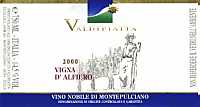
|
|
Vino Nobile di Montepulciano Vigna d'Alfiero 2000 |
|
| Tenuta Valdipiatta (Italy) | |
| Grapes: Prugnolo Gentile | |
| Price: € 21,00 | Score: |
| This wine shows a brilliant ruby red color and nuances of garner red, little transparency. The nose reveals good personality with intense, clean, pleasing, elegant and refined aromas that start with hints of black cherry and violet followed by good aromas of raspberry, blueberry, plum, tobacco, licorice, vanilla, chocolate, menthol and pleasing hints of cinnamon and nutmeg. In the mouth has good correspondence to the nose, a slightly tannic attack and however well balanced by alcohol, full body, intense flavors, good tannins. The finish is persistent with good flavors of plum and black cherry. A well made wine. Vigna d'Alfiero ages for 18 months in barrique followed by 12 months of aging in bottle. | |
| Food Match: Roasted meat, Braised and stewed meat, Game, Hard cheese | |

|
|
Fastaia 2001 |
|
| Ceuso (Italy) | |
| Grapes: Nero d'Avola (70%), Cabernet Franc (15%), Merlot (15%) | |
| Price: € 16,00 | Score: |
| This wine shows an intense ruby red color and nuances of ruby red, little transparency. The nose reveals intense, clean, pleasing and elegant aromas that start with hints of black cherry, plum and blueberry followed by aromas of blackberry, violet, licorice, vanilla and hints of carob. In the mouth has good correspondence to the nose, a slightly tannic attack and however balanced by alcohol, good body, intense flavors, good tannins. The finish is persistent with flavors of black cherry, blueberry and plum. Fastaia ages for 6 months in barrique followed by an aging in bottle of 4 months. | |
| Food Match: Roasted meat, Broiled meat and barbecue, Stewed meat, Hard cheese | |

|
|
Custera 1999 |
|
| Ceuso (Italy) | |
| Grapes: Nero d'Avola (50%), Cabernet Sauvignon (30%), Merlot (20%) | |
| Price: € 24,00 | Score: |
| The wine shows a brilliant ruby red color and nuances of garnet red, little transparency. The nose reveals good personality with intense, clean, pleasing, refined and elegant aromas which start with hints of black cherry jam and plum followed by aromas of blueberry, carob, violet, licorice, tobacco, vanilla and pleasing hints of black pepper. In the mouth has good correspondence to the nose, a slightly tannic attack and however well balanced by alcohol, intense flavors, full body, good tannins. The finish is persistent with good flavors of blueberry and black cherry. A well made wine. Custera ages for 12 months in barrique, for 4 months in concrete tanks and for 18 months in bottle. | |
| Food Match: Roasted meat, Braised and stewed meat, Game, Hard cheese | |
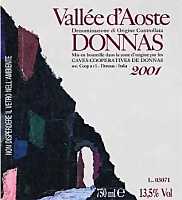
|
|
Vallée d'Aoste Donnas Napoleone 2001 |
|
| Caves Cooperatives de Donnas (Italy) | |
| Grapes: Nebbiolo (95%), Freisa, Neyret (5%) | |
| Price: € 9,00 | Score: |
| This wine shows a brilliant ruby red color and nuances of ruby red, moderate transparency. The nose reveals intense, clean and pleasing aromas that start with hints of cherry and raspberry followed by aromas of blueberry, plum, violet, cyclamen and hints of vanilla and cinnamon. In the mouth has good correspondence to the nose, an alcoholic and slightly tannic attack however balanced, good body, intense flavors, pleasing crispness. The finish is persistent with flavors of cherry and raspberry. This wine ages in barrique for 8-12 months, in cask for 8-12 months and for 8 months in bottle. | |
| Food Match: Roasted meat, Sauteed meat, Broiled meat, Hard cheese | |
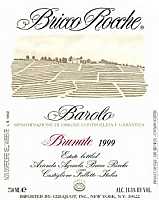
|
|
Barolo Bricco Rocche Brunate 1999 |
|
| Ceretto (Italy) | |
| Grapes: Nebbiolo | |
| Price: € 55,00 | Score: |
| This wine shows a brilliant ruby red color and nuances of garnet red, moderate transparency. The nose reveals good personality with intense, clean, pleasing, elegant and refined aromas which start with good hints of violet and cherry jam followed by intense aromas of black cherry, raspberry jam, plum jam, blueberry, licorice, tobacco, dried rose and pleasing hints of vanilla, cocoa, leather and menthol. In the mouth has very good correspondence to the nose, a slightly tannic attack and however well balanced by alcohol, full body, intense flavors, good tannins, pleasing crispness. The finish is persistent with good flavors of plum, raspberry and blueberry. A well made wine. This Barolo ages in cask. | |
| Food Match: Braised and stewed meat, Roasted meat, Game, Hard cheese | |

|
|
Moscato d'Asti 2003 |
|
| I Vignaioli di S. Stefano (Italy) | |
| Grapes: Muscat Blanc | |
| Price: € 10,50 | Score: |
| This wine shows a pale straw yellow color and nuances of greenish yellow, good effervescence. The nose reveals intense, clean, pleasing and elegant aromas which start with good hints of peach, litchi and the typical aromaticity of the grape followed by good and intense aromas of banana, melon, pear, broom and pleasing hints of sage. In the mouth has an effervescent attack with a pleasing sweetness and well balanced by crispness, intense flavors, delicate, sweet and very pleasing. The finish is persistent with good flavors of grape, peach and litchi. A well made wine. | |
| Food Match: Cream desserts, Pandoro, Panettone, Semifreddo | |

|
|
Cuvée Imperiale Brut |
|
| Guido Berlucchi (Italy) | |
| Grapes: Chardonnay (60%), Pinot Noir (30%), Pinot Blanc (10%) | |
| Price: € 12,00 | Score: |
| The wine shows a pale greenish yellow color and nuances of greenish yellow, good effervescence, fine and persistent perlage. The nose reveals clean and pleasing aromas that start with hints of banana and yeast followed by aromas of pineapple, acacia, bread crust, litchi and pear. In the mouth has good correspondence to the nose, a crisp and effervescent attack however balanced, intense flavors, good body, agreeable. The finish has good persistence with flavors of pear and pineapple. This sparkling wine is produced with the classic method. | |
| Food Match: Fish appetizers, Pasta and risotto with fish, Sauteed fish, Crustaceans | |
Camartina: Vertical TastingWe had a vertical tasting of three recent vintages of the renowned Querciabella's Camartina. A wine to the top of Italian enology since ever, a position widely confirmed by the result of our vertical tasting |
|
Among the wines of Tuscany a place of honor is certainly owed to Querciabella's Camartina that since many years it reached the top of Italian enology. We did a vertical tasting of three vintages of this renowned wine: 1997, 1999 and 2000. All the three vintages have shown an excellent level of quality as well as wonderful promises for a splendid evolution in the next years. What impresses of Camartina is its reliability and its precision which is always repeated: despite the differences of every single vintage, the result is always a great wine with exceptional class and personality which do not leave indifferent. The 1997 is splendid: despite of its 6 years of age, certainly too few for a wine like this, it shows an enviable youth which gives good promises for a wonderful aging. The same consideration can be done for 1999, whereas the 2000, the younger of the three, is characterized by freshness of aromas and flavors. Something to be certain of is that, just like the other two, the 2000 will be capable of giving wonderful emotions to the ones who will be patient in waiting great things to happen.
|
||||||||||||||||||||||||||||||||||||||||||
Matteo CorreggiaThe enological history of Roero is indissolubly tied to Matteo Correggia, the young vintner who was capable in few years to create wines of absolute greatness and to make his land great |
|
In Piedmont, noble wine land, north from the renowned Langhe there is an interesting wine area which is called Roero and recently it is getting more and more successful and esteemed. Whether Roero was successful in becoming a reference wine area of the Italian enology, it owes its fame to a young vintner, talented and of genial intuitions, as well as being convinced of the potentiality of the wines of his land: Matteo Correggia. In little more than ten years Matteo Correggia was successful in leaving an indelible sign in the history of the Piedmont's enology: his wines, since the beginning of his activity, have always been successful and appreciated everywhere, conquering awards and appreciations in every place. Fate wanted Matteo Correggia not to be with us anymore. An absurd and tragical accident happened in June 2001, while he was working in his vineyard, took away one of the most brilliant and genial wine producers. The ones who knew him, unfortunately, we did not have this privilege, remember him as a modest and talented person, everyone considered him as a master for the teachings he left, not only as a wine producer. It is not hard to believe because if it is true that a wine resembles the personality of the one which made it, Matteo Correggia's wines have always been examples of greatness and of excellent quality.
Most of the estates now part of the Matteo Correggia Winery have been inherited by the homonymous Matteo's grandfather, who in 1935 divided with his brothers the patrimony of great grandfather Giovanni Battista. The farm was started by Matteo Correggia's grandfather and subsequently by his father Giovanni, and it was mainly oriented to the typical polyculture of Roero until 1980's. Viticulture has always been a fundamental activity of the farm, however they also cultivated fruits, in particular peaches, and the winery business was limited to the processing of a small part of grapes harvested in the vineyards. The production of wine was, at that time, an activity destined for the familiar consumption and for few friends. The sudden and premature death of Giovanni Correggia, happened in 1985, forced Matteo, at that time 23 years old, to take the responsibility of the farm and he then decided to further orient the business towards wine production. Two years later Matteo Correggia bottled for the first time part of his wine production, therefore beginning a course oriented to wine production of absolute quality. This choice also forced the consequent abandoning of the production of all the other farm products. Matteo Correggia modifies the farm's business and decides to make quality wine only and he started the renewal from the vineyards, trying to adopt the best productive results, from pruning to the selection of bunches done in summertime, and continuing this work in the cellar thanks to the adoption of modern equipments. Matteo Correggia's winery evolved from the initial 8 hectares (about 20 acres) to the present 20 (about 50), with a yearly production of about one hundred thousand bottles and eight different wines. In the dreams of Matteo Correggia there is also the firm will to make Roero's wine great. There was an abandoned house in Bricco Pecetto, among the Rocche, which attracted Matteo Correggia's attention, convinced that in that place so rich in history could begin the research for his future Roero wine. The history of that bricco is dated back to 1242 and it was property of Counts Malabaila and of Roero and later of some anonymous farmers. Matteo Correggia finally succeed in buying that bricco and sees his dreams to turn into reality and therefore begins a work that will lead to the creation of one of his great wines. He decided that place should have a name and in picking one he was inspired by the word Pecetto used in that place, a dialectal term used to call pessere, that is the pine trees bordering the vineyard. He then decided to call it Ròche d'Ampsej, a lexical form perpetuated by the rural culture of that place: it was the first step towards the creation of a great wine that will have the same name. On June 13th, 2001, a cruel fate wanted that two days after his family, his land and his people would be deprived of Matteo Correggia. His work is still remembered by the ones who knew him, in his wines and in his land. His name has remained in his winery and to the memory of humanity. The asteroid 1984 EQ discovered on March 6th, 1984 by Edward Bowell in the Observatory Station of Anderson Mesa in the astronomical observatory Lowell at Flagstaff (Arizona, USA), thanks to the impulse of the friend and astronomer Vincenzo Zappalà, was named after Matteo Correggia therefore passing its name to the memory of time and humanity. Once again the history of this family and of its work was marked by a cruel fate and, once again, the determination and will of the ones who were remained continued the course in the respect of the ones who preceded them. Thanks to the support and help of friends and of the ones who knew Matteo Correggia, today is his wife Ornella who continues the valuable work of his husband, by continuing to realize the projects Matteo with determination and foresight started, supported by Luca Rostagno, the young and talented wine maker Matteo wanted to work in his winery. It is right in this spirit that Ms. Ornella runs the winery, aiming everything to quality and because the name of Matteo Correggia will not be forgotten, because his teachings may still be alive in the wines of the winery, symbols of excellence without compromises, masterpieces the human genius can get from its work. The wines produced by the winery are all interesting and of excellent level. The monumental Roero Ròche d'Ampsej, the most representative one of the winery, is a great wine produced with Nebbiolo grape and aged for 20-22 months in cask, Barbera d'Alba Marun, aged in cask for 18-20 months, and Nebbiolo d'Alba La Val dei Preti, aged in cask for 18-20 months, represent the top wines of Matteo Correggia winery. Of remarkable interest is also Anthos, a dry wine produced with Brachetto grape according to an ancient local tradition, and Langhe Bianco Matteo Correggia, produced with Sauvignon Blanc and aged in barrique with intense and pleasing flavors and aromas. The winery also produces a Roero Arneis, made with the homonymous local white berried grape, a very good Barbera d'Alba and the valuable Langhe Rosso Le Marne Grigie.
|
||||||||||||
|
Score legend Prices are to be considered as indicative. Prices may vary according to the country or the shop where wines are bought |
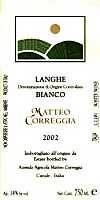
|
|
Langhe Bianco Matteo Correggia 2002 |
|
| Matteo Correggia (Italy) | |
| Grapes: Sauvignon Blanc | |
| Price: € 22,50 | Score: |
| This wine shows a brilliant straw yellow color and nuances of greenish yellow, very transparent. The nose reveals good personality with intense, clean, pleasing, elegant and refined aromas which start with intense and pleasing hints of peach and pineapple followed by good and intense aromas of acacia, banana, elder, litchi, apple, hazelnut, pear and pleasing hints of vanilla. In the mouth has good correspondence to the nose, a crisp attack and however balanced, good body, intense flavors, agreeable with a pleasing crispness. The finish is persistent with good flavors of peach, pear, pineapple and banana. A well made wine. Part of this wine ages in barrique for 9-10 months and for about 10 months in bottle. | |
| Food Match: Fried fish and crustaceans, Pasta and risotto with fish and crustaceans, Broiled fish | |
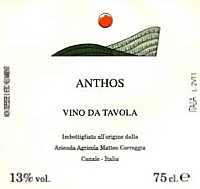
|
|
Anthos 2002 |
|
| Matteo Correggia (Italy) | |
| Grapes: Brachetto | |
| Price: € 8,50 | Score: |
| This wine shows a pale ruby red color and nuances of deep pink, transparent. The nose reveals intense, clean, pleasing and elegant aromas in which is clearly recognizable the typical aromatic character of the grape as well as good aromas of strawberry, rose, cherry, raspberry, plum, peach and cyclamen. In the mouth has good correspondence to the nose, a slightly crisp attack and however well balanced by alcohol, non aggressive tannins, good body, intense flavors. The finish is persistent with good flavors of strawberry, cherry and raspberry. Anthos is produced with Brachetto grape vinified in red. | |
| Food Match: Pasta with mushrooms and truffle, Sauteed and spiced meat , Roasted and spiced fish | |
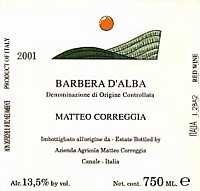
|
|
Barbera d'Alba 2001 |
|
| Matteo Correggia (Italy) | |
| Grapes: Barbera | |
| Price: € 12,50 | Score: |
| This Barbera shows an intense ruby red color and nuances of ruby red, little transparency. The nose denotes clean, intense, pleasing and elegant aromas which start with good hints of violet and black cherry followed by good aromas of blueberry, blackberry, carob, plum, tobacco, licorice and vanilla. In the mouth has good correspondence to the nose, a slightly tannic attack and pleasing crispness, however well balanced by alcohol, good body, intense flavors, good tannins. The finish is persistent with good flavors of black cherry, plum and blueberry. A well made wine. This Barbera ages for 6-7 months in cask. | |
| Food Match: Roasted meat, Stewed meat, Hard cheese | |
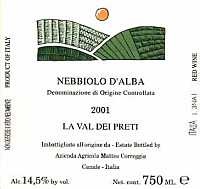
|
|
Nebbiolo d'Alba La Val dei Preti 2001 |
|
| Matteo Correggia (Italy) | |
| Grapes: Nebbiolo | |
| Price: € 22,50 | Score: |
| The wine shows an intense ruby red color and nuances of garnet red, little transparency. The nose reveals good personality with intense, clean, pleasing, refined and elegant aromas which start with hints of black cherry and violet followed by good and intense aromas of plum jam, blueberry, licorice, thyme, tobacco, vanilla and pleasing hints of cocoa. In the mouth has good correspondence to the nose, a slightly tannic attack with a pleasing crispness and however well balanced by alcohol, full body, intense flavors, good tannins. The finish is persistent with good and intense flavors of black cherry, blueberry and plum. A well made wine. This Nebbiolo ages for 18-20 months in cask. | |
| Food Match: Braised and stewed meat, Game, Roasted meat, Hard cheese | |

|
|
Barbera d'Alba Marun 2001 |
|
| Matteo Correggia (Italy) | |
| Grapes: Barbera | |
| Price: € 23,00 | Score: |
| The wine shows a beautiful and intense ruby red color and nuances of ruby red, little transparency. The nose reveals personality with intense, clean, pleasing, refined and elegant aromas which start with good hints of black cherry, plum and violet followed by good and intense aromas of blueberry, blackberry, tobacco, toasted wood, vanilla, licorice, eucalyptus as well as good hints of cocoa, black pepper and nutmeg. In the mouth has excellent correspondence to the nose, a slightly tannic attack and pleasing crispness, however well balanced by alcohol, full body, intense flavors, good tannins. The finish is very persistent with long flavors of plum, black cherry, blueberry and blackberry. A great wine. This Barbera ages for 18-20 months in cask. | |
| Food Match: Braised and stewed meat, Game, Roasted meat, Hard cheese | |

|
|
Roero Roche d'Ampsej 2000 |
|
| Matteo Correggia (Italy) | |
| Grapes: Nebbiolo | |
| Price: € 37,00 | Score: |
| Simply a great wine. This Roero shows a beautiful and intense ruby red color and nuances of ruby red, little transparency. The nose reveals personality with intense, clean, pleasing, refined and elegant aromas which start with good hints of black cherry, plum and violet followed by intense and good aromas of blueberry, blackberry, tobacco, thyme, licorice, menthol, vanilla and pleasing hints of black pepper and cinnamon. In the mouth has excellent correspondence to the nose, a slightly tannic and pleasingly round attack, however well balanced by alcohol, full body, intense flavors, good tannins, agreeable. The finish is very persistent with long and good flavors of black cherry, plum and blueberry. A great wine. Roche d'Ampsej ages for 20-22 months in cask followed by one year of aging in bottle. | |
| Food Match: Braised and stewed meat, Game, Roasted meat, Hard cheese | |
| Matteo Correggia - Case Sparse Garbinetto, 124 (Via S. Stefano Roero) - 12043 Canale, Cuneo (Italy) Tel. ++39 173 978009 Fax ++39 173 959849 - Winemaker: Luca Rostagno - Established: 1987 - Production: 100.000 bottles - E-Mail: matteo@matteocorreggia.com - WEB: www.matteocorreggia.com |
Cellar Journal |
|
This section is reserved to wine producers who want to publish news and information about their business, to announce new products or just for communicating to its customers information and promotions about their products and activity. Send news to be published at our e-mail address.
|
News |
|
In this section will be published news and information about events concerning the world of wine and food. Whoever is interested in publishing this kind of information can send us a mail at our address.
|
Personal CellarChoosing wines for a personal cellar in not always easy. Many factors should be carefully considered before proceeding to the purchasing of bottles that will make the personal patrimony of every wine lover |
|
The wish and the dream of every wine lover is to own a room expressly destined to the keeping of his or her wines. Unfortunately the ideal rooms full of joyous bottles to be uncorked in special occasions, often exists in dreams only and sometimes it is also good it is like that. This dream would be great to turn into reality because of the fact of owning good bottles, therefore allowing them to age properly and to appreciate them at their best possible condition. Sometimes it is good this to remain just a dream because one usually ends up to buy an excessive quantity of bottles, that inevitably get ruined because of the unfavorable keeping conditions, or because one simply has waited too long and the wine has lost its best qualities.
|
|
A frequent subject among wine lovers is about the so called “ideal cellar”, which does not only represent the best room and conditions to keep wine, but, first of all, the types and the number of bottles to buy for the “personal provision”. The ideal cellar, of course, is strongly conditioned by personal factors, including economic availability and the money one thinks wine is worth of, as well as the availability of a room really suited for the keeping of bottles. The majority of wine lovers, unfortunately, do not have in their houses rooms suited for the keeping of wine, not all have the privilege of owning a suitable room to be exclusively used as a cellar. For these reasons the number of bottles for the personal cellar is not high: the risk of getting them ruined would be high. Provided one does not want to collect bottles of wines or buy wines as a form of investment in the hope of a future economic revaluation, in the lack of a proper room for keeping, it is good to set a minimum number of bottles and to buy more wines in special occasions or when needed. In this sense it is better to keep a minimal number of bottles while leaving the “risk” of keeping to specialized shops which usually have proper rooms suited for storing bottles. It should be remembered the quality of the state of a bottle of wine sold in a shop is usually conditioned by the seriousness of the retailer and by the way he or she cares of the keeping of wines before selling them. Seriousness and honesty of a wine retailer is also determined by these factors, therefore, besides being a matter of trust, is also a matter of reliability. When the purpose of owning bottles is solely for the making of a personal cellar which wines are to be considered for personal consumption, it is therefore good and wise to limit the number of wines. It should be remembered the number of wines which are really suited for the aging in bottle for long period of time are very few. This is true for almost all white wines but also for many red wines which are usually believed to be suited for aging. Owning a sufficient and not exaggerated number of wines, in particular white wines, ensures a good replacement of bottles and the guarantee to taste the wine at its best moment. It should be also remembered that producers release their wines in the market when they believe them to be ready, that is in their optimal condition of appreciation. Of course this does not mean they are not suited for the aging in bottle, or that it is not advisable the aging of any wine, it simply means the choice of wines for aging should be done carefully by choosing wines which have been produced for this specific purpose.
The keeping of wine done in the aim of aging is not a pretty easy subject. First of all it should be determined a wine suited for aging and this initial and fundamental factor is not always easy to determine. In case we consider Cabernet Sauvignon grape, we can say, with a good approximation, its aging capacity is definable from four years to about twenty years, a pretty wide period of time. This means there are Cabernet Sauvignons that after 4 years are old and other that after 20 years are in good conditions and can continue they journey in time. Therefore a wine produced with Cabernet Sauvignon does not always offer a safe guarantee of keeping. There are many factors which determine the aging of a wine, among the many are to be mentioned the quality of grape and of cultivation, the climate and environmental conditions as well as the wine making techniques. These details are usually unknown to the average consumer, therefore, provided he or she exactly knows that specific wine and the condition of the vintage, keeping and aging have some level of risk. In this sense it would be good that producers would provide information in the labels about the aging potentialities of their wines. The myth a wine improves with time is not always true, often time irremediably deteriorates a wine, in particular white wines and those reds destined to an immediate consumption. The sad conclusion is that consumers, in order to obey to this golden rule of “real experts”, end up drinking a wine when it is too late instead of appreciating it when it could offer its best qualities. The ideal cellar is also realized by considering the personal preferences of its owner. In this sense it is good to decide the purpose of the cellar before proceeding with the purchasing of bottles. In case the purpose is to have wines to be matched with one's own meals, it is good to consider the typical foods present in one's own table and therefore purchasing the adequate wines. This means, for example, that in case your nutritional habits are mainly about vegetables, the occasions to uncork a bottle of robust red will be pretty few. Of course it is good to think of the purchasing of such wines because it is more likely that, sooner or later, or sometimes, one would eat a richer meal and that would require an equally rich wine. Last but not the least, the ideal cellar is also based according to the tastes of the owner, no matter of his or her nutritional preferences, therefore there will be always present those wines that are liked the most and that are frequently uncorked.
|
||||||||
|
No matter the size of the cellar and the number of bottles owned, it is always a good idea to arrange things for a good management. Even though you have few bottles, no matter this could seem useless, it is indispensable to properly manage the wines purchased and consumed. The management of the cellar does not requires special resources, it will be enough using a simple notebook where every cellar operation will be registered. In this sense the use of a computer software will certainly be useful: there are specific programs for the management of a cellar and they can be both purchased or downloaded by Internet. A simple application for the management of the cellar can be realized by using a properly personalized spreadsheet. It will be enough to register the name of the wine and of the producer, the vintage, the date of purchase, the position in the cellar and the potential period of aging. Other useful information include the place of purchase and price, the date of consumption, alcohol percentage as well as remarks about the wine. With time your cellar register will make a precious source of information about your consumptions and cellar economy, the trend of prices of the most consumed wines and, last but not the least, it will be useful in determining the bottles which are about to get too old or that reached their best time of appreciation. The cellar register will be updated every time a bottle of wine is being purchased or consumed and when the position of a bottle has changed: it will strictly reflect the real and historical condition of your cellar. Even though the compilation of a cellar register seems to be exaggerated or useless, with time its function will certainly be appreciable and it will certainly be worth the time of few minutes spent in taking notes of the operations.
|
|
As soon as a room of the house has been chosen for the keeping of wines, or it was decided to use a cellar-fridge, we can start filling the positions with bottles of wines. A personal cellar represents both the preferences of the owner and his or her attitudes and habits to offer wines to his or her guests and friends. Before starting buying bottles of wine for the personal and new cellar, it is good to set a budget for the initial purchase as well as deciding both the quantity and the quality of wines to be bought. In particular in the beginning - an useful advice for neophytes - it is more likely that one is going to be excited by the idea of the cellar and ends up spending more money than one would believe: this is something that may frequently and easily happen when purchasing certain wines. In your initial plans it is good to take advice from the ones having a better experience, in this sense the advices of a honest and expert wine shop manager will certainly be useful. Try to use the money destined for your cellar to the purchasing of assorted types of wines in order to have the right wine at the right time. For example in case your preference is for white wines, they will be the ones more present in your cellar, however it will also be wise to purchase some types of wine as well. A good cellar is also determined by its flexibility and versatility. Try to ideally divide your cellar in types while making sure that for every type of wine are bought one or two different bottles. A good division could be made according to the following types: sparkling wines, light white wines, structured white wines, rose wines, young red wines, aged red wines, sweet and fortified wines. These categories can be further divided according to the number of wines to be purchased. For example the category of sparkling wines can be divided into Charmat sparkling wines and classic method sparkling wines, as well as aged red wines can be divided into structured wines, full bodied wines and wines to be aged. In case the cellar you are going to set up is also your very first cellar, it is not however wise to purchase a high number of bottles. First of all it is good to test the suitability of the room to be used as a cellar and, last but not the least, you personal attitude as a cellar manager. For this reason it is advisable not to exceed 40 bottles of wines for your first cellar: this will also be useful to understand the exact measure of your consumption. In case your cellar is particularly suited for the keeping of wine, you can certainly proceed with the purchasing of valuable wines and destined to the aging in bottle. However this is a decision that should be made when one is sure about the real keeping possibilities of the cellar and, moreover, of the measure of your passion for the beverage of Bacchus. Realizing a personal cellar, besides ensuring a good availability of wines to be consumed in the best occasions, allows the improvement of one's own wine culture. Ideally every wine has its own characteristics which are most of the times unrepeatable, tells about the place where it is from and about the persons who made it. Ideally, knowing wine is, in a sense, knowing the culture of the places of the world. The glass can therefore be the witness of the smells and tastes of a place and of its land, a tale that should be carefully listened. The personal cellar therefore keeps the memories and the colors of the places of the world to be discovered: a journey which begins at the uncorking of every bottle and every wine and every bottle have an unique story to tell. Having a good cellar and to be able to properly manage it also means to respect the wine it keeps and therefore oneself. If the wines kept in your cellar are respected this also means knowing the right way to appreciate wine: a pleasure made of special and unrepeatable moments, something which should never be abused.
|
||||
TomatoThe famous vegetable original from South America is now an indispensable ingredient of the cooking of every country where it is known and it is a concentrated of good health |
|
|
|
Tomato is a horticultural plant belonging to the family of Solanaceae (Solanum Lycopersicum). In Italy the name tomato is found for the first time in the famous “Herbarius” written by Pietro Mattioli. The etymology of the Italian name, pomodoro, comes from Latin pomum aureus (golden apple or fruit). In other languages, such as English, the term tomato is to be associated to the etymology of the Aztec version Xitotomate or Nahuatl Tomatl (Mexican origin). The plant can sometimes reach the height of two meters (6.5 feet) and because of the lack of a robust trunk it needs proper supports. The leaves are pretty long with a deeply carved side and its tap-root is made of many side roots. Flowers are in form of bunches and are present in all trunk long and in the branches. The plant is extremely adaptable, as it is spread in almost every part of the planet, however it prefers pretty compact soils, well drained, fresh and deep, a minimal germinative temperature of 12-13°C (53-55° F) and a temperature of 22-25°C (71-77° F) in order to develop and bear fruits. Tomato does not stand to drought, it needs plenty of water and in times of lacking of water it must be provided artificially. Tomato's fruits are called tomatoes, they are green or red colored berries of different sizes and shapes according to the variety; the pulp, having a sweet and sour taste, is rich in vitamins. The most common varieties are, for ribbed tomatoes: Marmande, Pantano, Samar, Saint Peter and Costoluto Fiorentino; for round smooths: Montecarlo, Money Maker, Sunrise and Ace; for stretched tomatoes: San Marzano, Napoli VF, Maremma and Romarzano. The main enemies of tomato are potato-beetle, which damages the roots of the plant, and aphids, which affect the tissues and deform leaves. Tomato has a worldwide production of more than fifty millions of tons. The main producers are United States of America, Russia, Italy, China and Turkey.
|
||||
|
The origin of the plant seems to be from South America, in particular Chile and Ecuador, where it lives as a wild plant because of the tropical climate and can bear fruits all year long, whereas in European regions, when cultivated outside, has a seasonal cycle limited to summertime. From here it spread in Central America and it was introduced in Europe by Spaniards in the sixteenth century. The cultivation of the tomato plant was already common before Columbus and it was used as an ornamental plant. Likewise we use flowers today, the plants that we now see in kitchen gardens were cultivated in gardens. The choice was not conditioned by its aspect: tomato was considered as a poisonous plant because of the high content of solanine, a substance considered at those times poisonous for humans, therefore it was not used for cooking. In 1544 the Italian herbalist Pietro Mattioli classified the plant of tomato among the poisonous species. It is not clear in which place and in what time tomato, considered as an ornamental and poisonous plant and mentioned in many popular legends, suddenly became for Europeans an edible plant. It should be noticed that neither inhabitants of South America used to eat the fruits of the plant. Even Europeans knew tomato as an ornamental plant and this was the use they made of it in the first years. In France it was common for men to give a little plant of tomato to women as a sign of love. From Europe, or perhaps more precisely from Spain, the tomato plant arrived in Morocco, therefore finding an ideal climate, and from there it spread all over the Mediterranean area. The use of the fruit as an edible vegetable seems to originate in the 1500's: Mattioli himself cited he heard in some Italian regions the fruit was consumed fried in oil. In southern Europe, as well as in Bohemia and England, from the seventeenth century on it begins to be consumed fresh and for the preparation of sauces. In northern Europe tomato, as a food, had many difficulties, maybe because of the presence of other wild plants that with their high contents of alkaloids were not suited for nutritional purposes. In 1820, with the purpose of denying the famous saying, Robert Gibbon Johnson ate a tomato in front of an astounded crowd therefore denying the strong conviction tomato was a poisonous plant. The spreading of tomato as a food was not stopped, it was further spread and Livingstone defined the principles of the selection of the tomato varieties. Among the people who greatly contributed to the spreading and the appreciation of this food is to be mentioned Lazzaro Spallanzani, who was the first one, in 1762, to discover that a meat extract boiled and kept in a sealed container did not get altered. In 1773, in Vincenzo Corrado's book “il cuoco galante” (the gallant cook) was read: «to serve tomatoes it is needed to roll them in live charcoal or, for a short time, to dip them in boiling water and to remove the skin. Then seeds are to be removed either by cutting them in halves or by digging a hole». In 1809 Nicolas Appert, a French cook, published a book entitled “L'art de conserver les substances alimentaires d'origine animale et végétale pour plusieurs années” (the art of keeping food substances of animal and vegetal origin for many years). Whereas in France tomato was mainly consumed in the royal court, in Italy it rapidly spread in the cooking of the common people.
One year later, in 1810, the English Peter Durand patented the can of tin which was subsequently used both by Bryan Donkin and the American Woodhull Crosby who in 1847 commercialized the first cans of tomatoes. In the meantime in Italy, in 1839, Ippolito Cavalcanti in his book “Cucina teorico - pratica” (theoretical and practical cooking), describes the tomato sauce as the ideal condiment for durum wheat pasta. The industrial production of tomatoes was probably started by the Piedmontese Francesco Cirio around the end of the nineteenth century. From this moment on begins the production of derivatives. In 1888 chevalier Brandino Vignali started the industrial production of tomato extract. Almost at the same time in the province of Salerno (Italy) is being studied and developed a technique for the production of peeled tomatoes, a technique used with the stretched shaped tomatoes cultivated at the feet of Vesuvius. Almost a dominant ingredient in the Neapolitan cooking, very common in the Italian cooking and in every part of the world because of its qualities, its organoleptic qualities have however delayed its consumption as an edible vegetable. It certainly was genial to add tomato sauce to pizza, therefore making and still making happy the palates of the lovers of this traditional food of the Neapolitan cooking. In the American continent, both in the South, homeland of tomato, and in the North, the spreading of the plant as a food met lots of difficulties. It seems that some rivals of Abraham Lincoln convinced the cook of the White House to use tomato for the making of some foods in order to poison him. Of course the plot was revealed and therefore contributing to the spreading of tomato, it cleared every doubt about the poisonous effects of the vegetable and Lincoln became an enthusiastic consumer. There also are extravagant beliefs and legends about the properties of tomato. In the 1500's and in the 1600's tomato was believed to have aphrodisiac and exciting effects, for this reason was used in magic potions by the alchemists of that time. This also explains the reason of the names tomato had in the past in the many languages: in English “love apple”, in French “pomme d'amour”, in German “Libesapfel”, in Italian “pomo d'oro”, definitions which are connected to love. With the exception of Italian, the old names have been replaced and derived by the Aztec “tomatl”. However the origin of this name was because of a mistake, that is a misunderstanding, in fact the plant imported by Spaniards in Europe was called by Aztec “xitomatl”, whose meaning is “big tomatl”. Tomatl was another plant, similar to tomato but smaller and with yellow-green colored fruits. This plant, today known as tomatillo, is still used in the traditional cooking of Central America. Spaniards used to call both plants tomate and this was the cause of the mistake.
|
||||||||
|
Tomato is a concentrated of good health: it has refreshing properties, aperitifs, astringent, quenching, diuretics and digestive, in particular for starches. Tomato is rich in nutritional elements: vitamin A, vitamin B1, vitamin B2, vitamin B6, vitamin C, vitamin E, vitamin K and vitamin PP, as well as phosphor, iron, calcium, boron, potassium, manganese, magnesium, iodine, copper, zinc, sodium, sulfur, citric acid, malic acid, sugar, biotin, niacin, folic acid and provitamin A. Tomato is also rich in carotenoids, powerful antioxidants capable of catching free radicals and therefore protecting cells. Tomatoes are very suited for the ones who practice sports because of their high content in potassium useful for the prevention muscular cramps. 100 grams of fresh tomato contains about 93% of water, 3% of carbohydrates, 0.2% of fats, 1% of proteins and 1.8% of fibers. The energetic contribution is of 100 Kj (about 20 Kcal). It is important to notice that fats and proteins are found in seeds, that is the part which is not generally used for human nutrition. It is suited for the ones who undergo a weight loss diet because of its low contents in calories. Despite the fact tomato has many properties, it is not recommended to anyone, in particular to those persons who have problems of foods intolerance or allergies. The histamine contained in the fruit is one of the main substances responsible for allergies. Green tomatoes contain solanine, a toxic and irritating substance which can also cause headaches. Thanks to malic acid, arabic acid and lactic acid, tomato promotes digestion. Minced tomato leaves spread on the skin can be used as a remedy for insects bites. This property is probably because of alpha-tomatine, exclusively contained in the green part of the plant, an alkaloid having antibiotics, insecticide, insectifuge, fungicide and antibacterial qualities. It seems to be a good remedy for inappetence, high azotemia, atherosclerosis and for many stomach and bowel diseases. All these nutritional properties are referred to raw tomato, fresh and ripe. It seems some English scientists are experimenting on the genetic modification of tomato by adding the gene of a petunia, a herbaceous plant of tropical America and belonging to the Solanaceae, in order to enrich the fruit of flavonoids, beneficial substances for the heart and for the prevention of cancer.
|
|
Tomato is generally used in cooking as a vegetable, however in some parts of the world it is considered as a fruit just like apples, pears and bananas. The varieties of tomato for salads are usually round shaped and can be smooth or ribbed. To the classical varieties are more and more preferred hybrids because they can produce higher yields both in terms of size and of development, a better productive stability and a better resistance to diseases. Tomatoes to be used for sauces have a red-green color according to their ripeness, the consistency of the pulp must be good. The size is generally pretty big for the majority of varieties, with the exception of “cherry tomatoes”. The pulp must be thick and compact, not sour. The tomato is commercialized all year long and tomatoes for salads can be kept up to ten days at a temperature of 1-2°C (34-36° F) and a relative humidity of 85-90%. Whereas in varieties for sauces the skin has an intense red color, the pulp is pink colored, good consistency and a not sour taste. At a temperature of 1 or 2° C and a relative humidity of 85-90% they too can be kept for about ten days. The “pomodoro di Pachino” (tomato from Pachino) is the first IGP tomato (Indicazione Geografica Protetta, Protected Geographic Indication). Consumers can recognize this product thanks to the logo depicting Sicily with a circle in the eastern part, where the production area is located, inside a green colored rhombus with rounded corners. The first cultivations are dated back to 1925 along the coastal area of Sicily, irrigated with water from aquiferous wells. The particular area is characterized by pretty high temperatures, a high irradiation of sun rays, from the vicinity of the sea which mitigates the climate and prevents spring night frosts. All these factors, including the particular water used for irrigation, make “pomodoro di Pachino” a unique product, having particular organoleptic qualities. Producers must record their estates in a proper register which is submitted every year to the control department in order to ensure the origin of the product. Even structures used for the packing of the product must undergo specific controls and must be recorded in specific registers. Fresh tomatoes can be generally kept in the refrigerator for three or four days, however they can also be frozen - minced or in form of sauce - and kept in the refrigerator up to nine months. Before cooking tomatoes it is better to remove seeds and to peel them by submerging for thirty seconds in boiling water.
|
Wine Parade |
|
|
| The best 15 wines according to DiWineTaste's readers. To express your best three wines send us an E-mail or fill in the form available at our WEB site. |
| Rank | Wine, Producer | |
|---|---|---|
| 1 |
| Alto Adige Gewürztraminer Kolbenhof 2002, Hofstätter (Italy) |
| 2 |
| Franciacorta Cuvée Annamaria Clementi 1996, Ca' del Bosco (Italy) |
| 3 |
| Margaux 2000, Ségla (France) |
| 4 |
| Fumé Blanc Napa Valley 2001, Grgich Hills (USA) |
| 5 |
| Syrah Winemaker's Lot Vic 3, Concha y Toro (Chile) |
| 6 |
| Masseto 1998, Tenuta dell'Ornellaia (Italy) |
| 7 |
| Colli Bolognesi Pignoletto Superiore “Prova d'Autore” 2001, Bonfiglio (Italy) |
| 8 |
| Barolo Brunate 1999, Enzo Boglietti (Italy) |
| 9 |
| Turriga 1998, Argiolas (Italy) |
| 10 |
| Capo di Stato 1998, Conte Loredan Gasparin (Italy) |
| 11 |
| Amarone della Valpolicella Classico Capitel Monte Olmi 1999, Tedeschi (Italy) |
| 12 |
| Sauvignon Blanc Reserve Marlborough 2002, Kaituna Hills (New Zealand) |
| 13 |
| Anjou 2001, Domaine de Montgilet (France) |
| 14 |
| Rioja Reserva Era Costana 1999, Bodegas Ondarre (Spain) |
| 15 |
| Barolo Cicala 1999, Poderi Aldo Conterno (Italy) |
| |||||||
Privacy Policy | |||||||


| Copyright © 2002-2024 Antonello Biancalana, DiWineTaste - All rights reserved |
| All rights reserved under international copyright conventions. No part of this publication and of this WEB site may be
reproduced or utilized in any form or by any means, electronic or mechanical, without permission in writing from DiWineTaste. |